Suikinkutsu is a traditional Japanese garden ornament that creates soothing, melodic sounds from dripping water within a buried ceramic pot. This unique feature enhances a Zen garden's tranquil atmosphere, promoting relaxation and mindfulness. The delicate acoustics of a suikinkutsu blend seamlessly with natural elements, offering a serene auditory experience for pet owners and their animals.
Introduction to Suikinkutsu in Zen Gardens
Suikinkutsu, a traditional Japanese water harp, enhances Zen gardens by creating soothing, melodic sounds through water droplets falling into an underground ceramic pot. This acoustic art form epitomizes the Zen principles of tranquility and contemplation, enriching the sensory experience of the garden. Integrating Suikinkutsu fosters mindfulness, encouraging visitors to embrace silence and natural harmony.
Historical Origins of Suikinkutsu
Suikinkutsu originated during the Edo period in Japan, emerging as an innovative feature in traditional Japanese gardens. This unique water harp device consists of an underground ceramic pot that produces soothing, musical sounds when water drips into it. It reflects the Japanese aesthetic principles of wabi-sabi, emphasizing simplicity, tranquility, and the beauty of natural imperfection.
Fundamental Design Principles of Suikinkutsu
Suikinkutsu's fundamental design principles center on the harmonious integration of water, sound, and natural materials to create a peaceful auditory experience. The underground ceramic pot acts as a resonating chamber, capturing water droplets that fall from a bamboo spout to produce serene, melodic sounds. Key elements include precise placement of the spout, careful selection of pot shape and size, and the use of gravel or sand to enhance sound resonance and maintain aesthetic balance within the Zen garden.
Architectural Elements and Material Selection
Suikinkutsu, a traditional Japanese garden ornament, integrates architectural elements such as underground ceramic pots designed to capture and amplify the sound of dripping water. The material selection prioritizes smooth, glazed ceramics for resonance and durability, paired with carefully arranged gravel and stones above to facilitate water flow and acoustic clarity. This harmonious combination of architecture and materials creates a serene auditory experience intrinsic to Zen garden design.
Acoustic Features: The Music of Water Drops
Suikinkutsu produces delicate acoustic features through water droplets falling into a buried ceramic pot, creating soothing, echoing sounds reminiscent of distant bells. This natural water music enhances the meditative ambiance of a Zen garden by blending rhythm and silence in a harmonious manner. The subtle reverberations stimulate mindfulness and deepen the sensory experience within the garden's tranquil environment.
Integration with Traditional Zen Garden Layouts
Suikinkutsu, a traditional Japanese water harp, integrates seamlessly into Zen garden layouts by enhancing the tranquil ambiance with its subtle, resonant sounds produced when water drips into an underground cavity. Placed near stone basins or water features, its placement respects the minimalist aesthetic and balance of the garden's natural elements, fostering meditation and mindfulness. This harmonious inclusion underscores the Zen principles of simplicity, silence, and the appreciation of sensory experience in garden design.
Cultural and Spiritual Symbolism of Suikinkutsu
Suikinkutsu, an exquisite element of traditional Japanese Zen gardens, symbolizes tranquility and the harmonious connection between nature and human presence. The melodic water sounds produced by suikinkutsu invoke mindfulness, reflecting the Zen principles of impermanence and meditation. This cultural artifact embodies spiritual purification, encouraging introspection and a deep appreciation for subtle natural beauty.
Modern Interpretations and Innovations
Modern interpretations of the Suikinkutsu utilize advanced materials like acrylic and resin to enhance sound clarity and durability, diverging from traditional ceramic bowls. Innovations include integrating solar-powered LED lighting that accentuates the water droplets' rhythmic sounds, creating a multi-sensory experience. Contemporary designs often incorporate customizable resonating chambers to tailor acoustic effects, blending ancient aesthetics with modern technology.
Maintenance and Preservation Techniques
Suikinkutsu maintenance involves regular cleaning of the buried ceramic pot to prevent algae buildup and sediment accumulation that can obstruct water flow and sound quality. Preservation techniques include ensuring proper drainage around the suikinkutsu to avoid water stagnation, which can damage the delicate structure and disrupt the acoustic function. Seasonal inspections and gentle rinsing with clean water help maintain the suikinkutsu's clarity and resonance, guaranteeing long-lasting enjoyment of its soothing sounds in a Zen garden.
Experiencing Suikinkutsu: Mindfulness and Tranquility
Experiencing Suikinkutsu in a Zen garden offers a unique opportunity to cultivate mindfulness through the soothing sound of water droplets resonating within a buried ceramic pot. This tranquil auditory experience encourages deep relaxation and presence, enhancing the garden's meditative atmosphere. The gentle, rhythmic echoes create a sensory connection to nature, promoting inner peace and reflection.
Suikinkutsu Infographic

 gardenot.com
gardenot.com